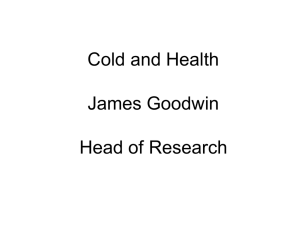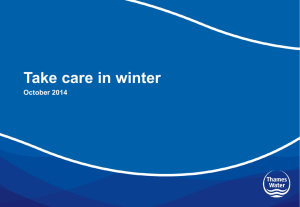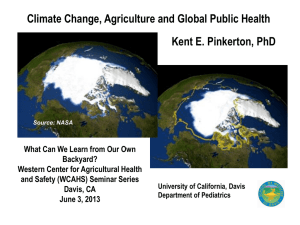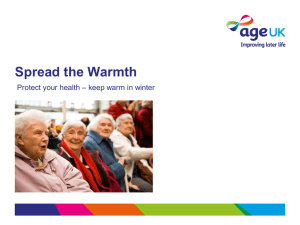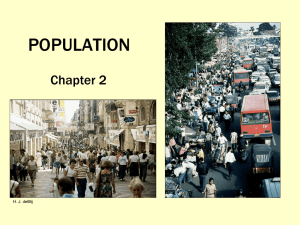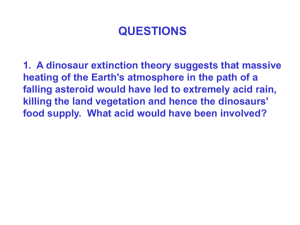Dr Anne O`Farrell - Energy Action Ireland
advertisement
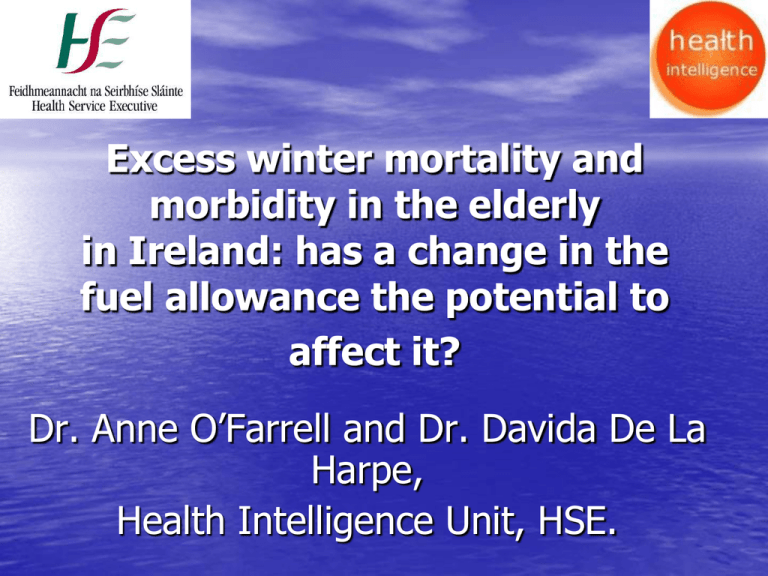
Excess winter mortality and morbidity in the elderly in Ireland: has a change in the fuel allowance the potential to affect it? Dr. Anne O’Farrell and Dr. Davida De La Harpe, Health Intelligence Unit, HSE. Background: • Excess winter mortality has been observed in Ireland and in other European countries.1 • The fuel allowance, which is means tested, can be regarded both as a proxy measure for poverty and as a real contributor to ameliorating the effects of poverty. • The increase in fuel prices together with the reduction of the fuel allowance from 32 weeks to 26 weeks could impact on the numbers suffering fuel poverty • McAvoy H. (2007) All-Ireland Policy paper on Fuel Poverty and Health. Dublin: Institute of Public Health of Ireland. Recent Headlines: Fuel Allowance cut to hurt the poorest of older people. SOURCE: Age Action, Jan. 2012 Older people going to bed at 7pm to save on fuel bills. SOURCE: The Irish Times – Sept. 2011. Struggle of Irish people to pay bills revealed in Credit Union survey. “The increases in energy and fuel costs have affected 85pc of people and 8pc said it is impossible to pay their bills each month”. SOURCE: IRISH INDEPENDENT, Monday 9th January, 2012 Gas price increases to add €150 to household bills. SOURCE: The Irish Times, Oct. 2011. Households receiving fuel allowance: 23.7% 25% 18.7% 20% 15.3% 14.9% N=264,400 N=274,000 N=286,200 N=290,000 N=300,000 2005 2006 2007 2008 2009 14.9% 15% 10% 14.7% 15.0% N=376,000 N=400,000 2010 2011 5% 0% Source: Dept of Social Protection, Sligo and Dept. of Environment, Community and Local Government. AIM: • The aim of this study was to determine whether the excess in winter mortality and inpatient hospital emergency admissions among the elderly is continuing in recent years 2005-2010. • To describe the causes of death and reasons for hospital in-patient admissions among the elderly in winter vs. summer months. Method: • Persons aged ≥65 years who died in Ireland in Winter months (i.e.Nov-Jan) versus Summer months (i.e. May-Jul) extracted from the CSO for years 20052009. • Patients aged ≥65 years who were admitted to acute hospitals as emergency admissions during winter months vs. summer months extracted from HIPE database. Mortality coming down in all age-groups-particularly in elderly: y = -20.648x + 823.53 25000 20000 15000 y = -455.97x + 19526 10000 5000 Rate per 100,000 population 900 800 700 600 500 400 300 200 100 0 0 20 0 20 0 0 20 1 0 20 2 0 20 3 0 20 4 0 20 5 0 20 6 0 20 7 0 20 8 09 Rate per 100,000 population Age standardised mortality rate for all cause mortality for all ages and those aged 85+ years by year. Year of death All Ages 85+ Linear (All Ages) Linear (85+) Mortality coming down in all agegroups: Age standardised mortality rate for older age groups by year. Rate per 1000 population 250 200 60-64 65-69 150 70-74 75-79 100 80-84 85+ 50 0 2000 2001 2002 2003 2004 2005 2006 2007 2008 2009 Year of death No. of deaths No. of deaths in elderly (aged 65+ yrs) by season of death (winter vs. summer)(All deaths) 30000 28000 26000 24000 22000 20000 18000 16000 14000 12000 10000 8000 6000 4000 2000 0 29339 26106 5969 5895 5823 5379 5640 53156012 5136 5211 5065 2005 2006 2007 2008 2009 20052009 Year Sum m er m onths Winter m onths N= 3,233 excess deaths in winter months vs. summer months over 5 year study period, average 650 excess deaths per year in elderly during winter compared to summer. Deaths from respiratory illness in those aged 65+ years 1079 No. of deaths 1200 1000 800 600 400 200 0 p 05 0 2 es -R ry o t ira 06 0 2 784 996 943 867 671 661 740 Summer months Winter months e D R 1043 849 hs t a p es to a ir ry 07 0 2 D R hs t ea p es to a ir ry 08 0 2 D R hs t ea p es to a ir ry 09 0 2 D R hs t ea p es to a ir ry D hs t ea 1,223 excess deaths in elderly due to respiratory diseases in winter vs. summer months over the 5 year study period. Deaths from circulatory illness in those aged 65+ years 2438 2015 2213 2021 ea th s 20 09 C irc ul at or y D ea th s D y at or 20 08 C irc ul at or 20 07 C irc ul C irc ul at or y D ea th s y D De a at or y 20 06 ea th s Winter ul -C irc 20 05 2463 2027 2365 1964 2324 2006 Summer th s No. of Deaths 3000 2500 2000 1500 1000 500 0 1,770 excess deaths in elderly due to circulatory diseases in winter vs. summer months Over the 5 year study period. Results: • Excess deaths due primarily to: – Respiratory diseases: 1,770/3,233 (54.7%) – Circulatory diseases: 1,223/3,233 (37.8%) • Dr. Elizabeth Cullen will present data on other countries’ experience and on the biological effect of lower temperatures. Moving on to hospital admissions: • HIPE data • over 65s emergency only • comparing winter admissions with summer admissions No. of emergency hospital in-patient admissions in elderly (aged 65+ yrs) by season (winter vs. summer): 35000 30000 28943 27601 30316 28615 2965030342 32926 29633 3040131413 2006 2007 2008 2009 25000 20000 15000 10000 5000 0 2005 Summer Admissions Winter Admissions N= 8,040 excess emergency in-patient hospital admissions in winter months vs. summer months over 5 year study period. Results: • Excess hospital admissions due primarily to: – Respiratory diseases: 7,129/8,040 (88.6%) 20052009 Summer Adms 20052009 Winter Adms % Diff Diff. I00-I99 Diseases of the circulatory system 32424 33447 1023 3.2% J00-J99 Diseases of the respiratory system 23312 30441 7129 30.6% R00-R99 Symptoms, signs and abnormal clinical findings 19475 19796 321 1.6% K00-K03 Diseases of the digestive system 15332 14682 -650 -4.2% S00-T98 Injury and poisoning 14288 15436 1148 8.0% C00-D48 Neoplasms 9642 9349 -293 -3.0% N00-N99 Diseases of the genitourinary system 7752 7620 -132 -1.7% G00-G99 Diseases of the nervous system 4370 4721 351 8.0% M00-M99 Diseases of the musculoskeletal system 4130 3712 -418 -10.1% E00-E89 Endocrine, nutritional and metabolic diseases 4123 4071 -52 -1.3% L00-L99 Diseases of the skin and subcutaneous tissue 3274 2743 -531 -16.2% D50-D89 Diseases of the blood and blood-forming organs 2592 2464 -128 -4.9% A00-B99 Certain Infectious and Parasitic Diseases 2587 2648 61 2.4% F00-F99 Mental and Behavioural Disorders 1216 1405 189 15.5% H00-H59 Diseases of the eye and adnexa 668 628 -40 -6.0% Z00-Z99 Factors influencing health status 350 367 17 4.9% H60-H95 Diseases of the mastoid process 320 361 41 12.8% 45 49 4 8.9% Q00-Q99 Congenital malformations Winter vs. Summer Admissions: Length of Stay: • Winter season = 1,842,691 bed days • Median LOS Winter = 7 days (range 1-850 days) • Summer season = 1,689,663 total bed days • Median LOS = 6 days (range 1-892 days) • Excess bed days used in winter season vs. summer season = 153,028 bed days. Winter vs. Summer Admissions: Estimated Acute Care Costs: (emergency admissions only) Hospital in-patient Costs 2005 2006 2007 2008 2009 2005-2009 inclusive Summer € 159,066,230.90 166,194,326.85 173,171,915.31 184,180,783.00 159,542,568.00 842,155,824.06 Winter € 172,223,977.14 178,388,950.96 184,676,111.81 192,154,259.00 175,857,058.00 903,300,356.91 Excess costs winter admission vs. summer admission = €61 million Discussion: • Winter excess mortality and morbidity still present in elderly although it has reduced over time. • Respiratory diseases and circulatory diseases over-represented. Discussion: • This study has found that more households than ever are in receipt of the fuel allowance. • The numbers of those assessed as suffering fuel poverty are increasing. • Although the direct overall cost has increased for the exchequer, the possible long-term cost of reducing the allowance and the wider consequences require further monitoring. Discussion: • The causes of the excess mortality still need further research as it is likely to be multifactorial. • Many of these deaths are likely to be avoidable and an hypotheses is that they are linked to poor housing, and temperature • Socio-economic factors come into play. Discussion: • Further research into the link between housing standards and in-adequate heating and excess winter mortality needs to be carried out. • However, a cut in the fuel allowance has the potential to exacerbate the problem among the elderly. Excess winter mortality in Ireland Energy Action Fuel Poverty Conference Dublin Castle February 6th Feb 2012 Dr Elizabeth Cullen Department Community Health HSE Outline of presentation • 1. Excess winter mortality • 2. How do cold temperatures affect health? • 3. Who is most vulnerable in Ireland? • 4. A look at other countries • 5. Conclusions 1: Excess winter mortality •We have seen from Anne’s slides, that we have excess winter mortality and hospital admissions in those aged 65 years and over during the study period 2005-2009. •Majority due to respiratory and circulatory diseases. •However, countries with warmest winters (over 5oC) tend to have highest rates •‘Paradox of excess winter mortality’ Shah and Peacock 1999 2: How do cold temperatures affect health? • Through the cardiovascular and respiratory systems • Cardiovascular disease is declining as a cause of mortality, but still causes a third of deaths in Ireland • Respiratory mortality has shown no fall, causing approximately 14% of deaths in Ireland • Almost a half of mortality in Ireland is temperature sensitive Cardiovascular Exposure to cold results in significant and prolonged changes in the general population Constriction of blood vessels leading to higher blood pressure Immediate changes in levels of chemicals which increase the tendency of blood to form clots. (Donaldson Keatinge and Allaway 1997) After six hours of mild cooling • Packed cell volume by 7% • Platelet count increased to produce a 15% increase in the fraction • • • of plasma volume occupied by platelets. Whole blood viscosity increased by 21%; Arterial pressure rose on average from 126/69 to 138/87 mm Hg. Plasma cholesterol concentration increased, in both high and low density lipoprotein fractions, but values of total lipoprotein and lipoprotein fractions were unchanged. Fibrinogen increased • • The increases in platelets, red cells, and viscosity associated with normal adjustments to mild surface cooling provide a probable explanation for rapid increases in coronary and cerebral thrombosis in cold weather. (Keatinge et al 1984; Neild et al 1995) Respiratory • Cold temperatures Can induce constriction of the airways. Cause delayed changes in increase in clotting factors in blood Also associated with indoor crowding, contributing to both cross-infection and a lowering of the immune systems resistance to respiratory infection. (Eurowinter, 1977; Donaldson et al 1998). 3: Who is most vulnerable in Ireland? • People suffering from cardiovascular and respiratory disease • The older population Mortality rate per 100,000 Observed Quadratic 1.2 1.0 0.8 0.6 0.4 -10 -5 0 5 10 15 20 25 Mean temperature Mortality from Ischaemic heart disease per 100,000 Irish population 1981-2004 Mortality rate per 100,000 Observed Quadratic 0.8 0.7 0.6 0.5 0.4 0.3 0.2 -10 -5 0 5 10 15 20 25 Mean temperature Mortality from respiratory disease per 100,000 Irish population 1981-2004 Mortality rate per 100,000 Observed Linear 0.8 0.6 0.4 0.2 -15 -10 -5 0 5 10 15 20 Minimum temperature Relationship between lagged minimum temperatures and mortality from respiratory disease per 100,000 R square 0.892 p<0.000 Mortality rate per 100,000 1.0 0.8 0.5 -10 -5 0 5 10 15 Mean temperature Mortality from cancer per 100,000 population 1981-2004 20 25 Increase in mortality below threshold temperature in Ireland 15-64 0.7% 65-74 2% 75-84 2.4% Over 85 3.9% Total 2% In accordance with national and international research (e.g. Aylin et al 2002, Eurowinter, 1997; Boulay et al,1999; Huynen et al, 2001; Moran et al, 2000; Goodman et al, 2004). 4 A look at other countries • Yakutsk is the world's coldest city, with temperatures averaging only −26.6°C during October to March • In Yakutsk, in the age groups studied: people aged 5059 and 65-74, mortality from cardiovascular disease and all causes was unchanged as temperature fell to - 48.2°C • Mortality from respiratory disease only increased as temperatures fell below −20°C (Donaldson et al 1998) Yakutsk • High winter mortality in such regions is largely preventable by warm housing and clothing • Room temperatures were 19.1°C at outside temperatures of -42°C An average of 4.2 layers of clothing were worn (Donaldson et al 1998) A comparison: Norway and Ireland 1986-1995 Ireland Norway Smoking prevalence 32% 33% Obesity 10% 9% Cholesterol High High Both countries are demographically similar (Clinch and Healy 2000) A comparison: Norway and Ireland Ireland Norway Roof insulation 100mm 200mm Wall insulation 40mm 125mm Floor insulation 25mm 150mm January temperature 5oC -1.1oC Average internal temperatures 15oC 21oC A comparison: Norway and Ireland Ireland Norway Crude mortality rate from cardiovascular disease/1000 population 4.1 4.9 Crude mortality rate from respiratory disease/1000 population 1.3 1.1 Excess winter deaths per day from cardiovascular disease 39.6 6.3 Excess winter deaths per day from Respiratory disease 4.3 Clinch and Healy 2000 24.3 (Walsh 2008 Statistical and Social Enquiry Society of Ireland) Excess winter mortality is clearly modifiable Recent reduction Mortality 1973-1999 2000-2006 Respiratory 82% 58% Ischaemic heart disease 27% 23% Crude 27% 18% Reduction in the peak to trough variation in winter mortality Walsh 2008 Statistical and Social Enquiry Society of Ireland Maximizing Ireland’s Energy Efficiency Measure Number of homes deficient Measures made to 2008 Wall insulation 60,836 3,807 Draught proofing 74,524 13,401 Roof insulation 54,752 17,982 Homes 18,465 Figures related to lowest income quintile (Dept. Communications, Energy and Natural Resources 2009-2020) Factors associated with excess winter mortality Warmer housing Increased spending on health care Reduced air pollution Impacts of better socioeconomic conditions “Remains a puzzle” Merits further research (Walsh 2008 Statistical and Social Enquiry Society of Ireland) Discussion: We know the importance of: good quality housing, heating, nutrition and clothing in counteracting the impact of cold in the Irish and international context (Moran et al, 2000; Middleton et al, 2000; Donaldson et al, 2001(a)). 5. Conclusion: A proportion of excess winter mortality is avoidable As you can see, we can monitor it We have the opportunity now to track the effects of socio-economic changes and other variables on excess mortality Further research needs to be done Avoidable mortality is a tragedy
